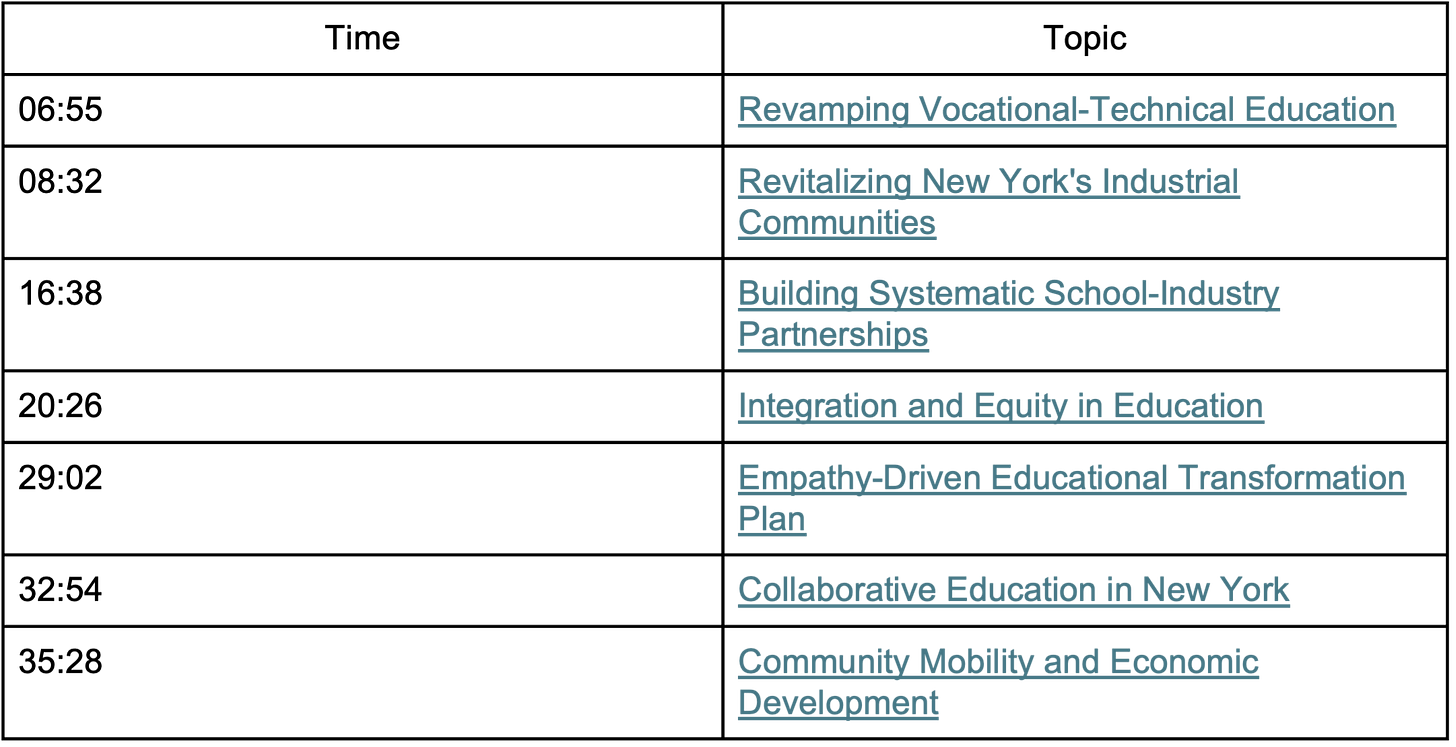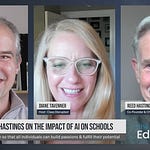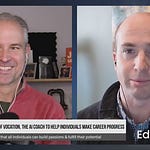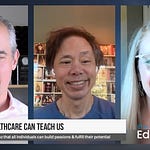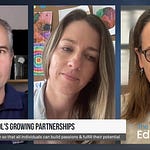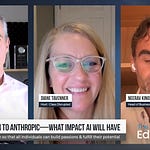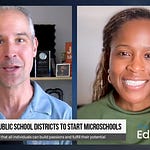In this episode, Danny Curtis interviewed Jonah Schenker, superintendent of Ulster BOCES in New York, to explore the launch of a groundbreaking new center for career and technical education at iPark87. The conversation dove into the innovative programming and community partnerships at the new center, the challenges of moving beyond traditional, industrial models of schooling, and the vital role of collaboration between educators, industry, and local organizations. Schenker also shed light on broader statewide reforms in New York around redefining student competencies, the importance of starting transformation with empathy and stakeholder input, and how these changes create new opportunities to equip students as designers of a better future.
Danny Curtis
Welcome to the Future of Education. I’m Danny Curtis and you’re joining the show where we are dedicated to creating a world in which all individuals can build their passions, fulfill their potential and live lives of purpose. And today to help us think through that, we welcome Dr. Jonah Schenker, superintendent of Ulster BOCES, which is a regional education services district in New York. And I’m really excited to have Jonah on today because he’s going to tell us about the innovative work that he is doing with his partner districts in New York, including the opening of a very new and very big center for career and technical education that’s playing an important role in a larger shift happening in New York towards rethinking student competencies. And so Jonah, thank you so much for joining us today.
Dr. Jonah Schenker
Awesome. I’m super glad to be here and actually recording from the new site as we were just chatting about. So I’m happy to be in space with you.
Danny Curtis
So cool. And we especially appreciate you carving out the time right now at time of recording. We are just leading into a new school year. So I’m sure this is a busy time for you.
Dr. Jonah Schenker
It’s always a busy time for schools as we think about opening but, but especially busy when you know, a new 140,000 square foot facility is, you know, just on, on the agenda as something to get opened as well.
Danny Curtis
So yeah, the big agenda item right there. Yeah, absolutely. Awesome. Well, I want to dig into that center in a second, but just to start, I’d love to hear about your journey to this work. What brought you to Ulster BOCES?
Dr. Jonah Schenker
Yeah, so you know, kind of the one minute overview, you know, I started my journey in school and I describe it as I was good at school, I knew how to do school. I don’t really recall, you know, what I was really getting at or, or absorbing. I recognize amazing teachers throughout that, but the learning style, the approach that that was always didn’t, didn’t feel right. And so I found myself gravitating towards shop class. I found myself gravitating towards clubs and extracurricular. But again I knew how to play the game. And so I got good grades, went off to college and did about two years and, and then left and spent my second two years of undergrad traveling around the world in an independent study.
Finished my undergrad that way and that was really where kind of the aperture opened up that there are more than, there’s more than one way to kind of get at this thing we call learning in school. Fast forwarding. Started my career at a new school startup in Brooklyn. Spent about five years there teaching. Taught for another three or four years after I left the city in Dutchess County, New York and then began my journey at Ulster BOCES 16 years ago as an administrator, assistant principal, teacher, coach and have worked through the progression of leadership all here at Ulster BOCES. So building principal and director and interim directors of portions of our entity that handle tech and professional learning. Had the opportunity to become the deputy superintendent here and then our superintendent at the time retired and that was the moment at which I had the opportunity to become the district superintendent.
And the district superintendent is an interesting role in a BOCES. One portion of the role is the CEO of the BOCES. So really handling like all the programming that we’re doing and then the other portion is a direct report for the commissioner through the New York State Education Department. And that’s the kind of two way conduit that offers or where we support districts in initiative that is coming out of the state education department and equally as important bringing up voice from the ground floor to help inform the Education department around decision making, policy and things like that. So it’s a different role. I’m very, very fortunate, wonderful board who supports innovation and about 10 years ago in one of my principalships I got the opportunity to start a school, a P Tech school, Pathways and Technology Early College High School. It’s a six-year program and, and that was really where I really began to become passionate around economic and workforce development, around the interconnectedness or the lack of interconnectedness of the entities that need to pull in the same direction on behalf of students if we’re going to really do this work. And that was done in kind of this micro school where we built out that model.
But tremendous amount of gains and I’m sitting here today in a center that represents the scalability of that same vision. And so I know we’re going to get to talk a little bit more about that, but I’ll pause there for you.
Danny Curtis
Yeah, yeah. That connects a lot of dots in the lead up to the present day. That day being just less than a week out from the opening of the new career and technical patterns at iPark87 as it’s called. Could you tell me more about the center and its services and give us a view into the story behind its development?
Dr. Jonah Schenker
Sure. So we run a ton of different types of programming that are student facing. We have a whole other, many other divisions that are non-student facing, workbook but focusing on the student facing career and technical education. So for the most part, students come to us in their junior and senior year as part of their journey through nine through 12 in our district, so in our county, our BOCES works with eight component districts. Those are the districts in our BOCES region. And so many of those students are progressing through the 22 credits and five Regents exams as part of the graduation requirements, which I know we’re going to get to later because that’s shifting as well. And they come up to us for either AM or PM and they’re engaged in career and technical education, automotive, culinary.
Revamping Vocational-Technical Education
Dr. Jonah Schenker
You know, we have, you know, all of the health occupations, a technology class, electrical, HVAC and go down the list, welding and, and they’re getting the technical skills. But also students are progressing through integrated academics as well. So they may be getting some math credits and science credits and English credits, et cetera and career in tech or as some, you’ll hear some people talk about VoTech or vocational tech is in the same kind of dilemma as our traditional education system where we are still very much for the most part operating in this kind of industrial model of schooling. And so we’ve been pushing on that for a decade across all of our programs. What should schools really be? What can schools be? And how do we move out of this industrial model of teaching and learning into something that’s more relevant for the students in order to prepare them for whatever next is. And so kind of going to the site here. The iPARK site is the former IBM site in Kingston, New York. So the story of that IBM, you know, headquarters, last I heard in, in this area of the facility, 6700 employees like you don’t go anywhere in Ulster county and have a conversation with somebody who didn’t move here, have an uncle or a cousin who were like worked here at the facility.
Revitalizing New York’s Industrial Communities
Dr. Jonah Schenker
And again my, you know, like many communities in New York, especially those with those kind of single massive industries that out-migrated, they left and it bottoms out a community, an economy, hope and really has been this for decades this legacy of failure where there had been several attempts to kind of think about how to revitalize this campus. The campus was turned over and purchased to National Resources who really did an amazing job at the cleanup from an ecological standpoint and making the site safe and working through that in partnership with many entities, county government and Environmental Protection Agency, etc and about eight years ago some conversations about like let’s take a look at this and, and some early conversations and some dialogues and again the ground is not always ripe for things to grow. And so that kind of fell short and then we took a break through that little period of time known as Covid and and I had the opportunity to step into this position and rekindle those conversations and kind of went at it with a little bit of a different strategy than prior and began to get steam on this concept. Right. And a lot of that I think is about preparation, meeting, opportunity, but also really the amount of groundwork to engage with our eight districts to see the why and the what and the how through transparent conversations rooted in what’s right for students, what’s right for kids. And so you know that, that took hold and we have become what will be the anchor, you know, for this campus.
The career and technical school that will be here is amazing. I was saying for a while like it’s going to be amazing but I keep reminding myself actually that today about an hour before this conversation our, we had gotten our co from the town some time back but, but our sign off from the New York Education Department and the commissioner came through so, so it’s no longer like when it happens, it’s here and happening and the school is amazing. But, the campus represents so much, is so much larger. Right. It is an ecosystem that brings together county government, industry, two-year and four-year colleges. And really this messaging that I’ve been talking about has been a metaphor. Now we have a physical representation of the commitment of what it takes to really do economic and workforce development which is in turn, that is, skills and workforce gap work.
It is community revitalization work, it’s economic mobility work. So plans here for millions of square feet for other industries to be site-based housing. We know housing and employer and, and future employees are two critical pieces. So let’s not talk about how to solve them, let’s build that. And so this is the beginning, too, a multi-phase project to again do that work. Really, really exciting. And I could talk a little bit about when you feel it’s right about again what’s the next phase in terms of that larger conversation or larger impact because the school is going to be magnificent and it’s going to do wonderful things. But I’m really thinking about how this becomes a model to replicate out because we are not the only community and geography that is facing economic and workforce development conversations as well as this type of revitalization from out migration
Danny Curtis
Yeah, yeah. I’m excited to get there. Before we do, I want to stay with one point you brought up around the opportunities that being in this space, this larger campus with all of these different organizations around, opens up for partnerships. Because obviously with blended career technical education initiatives, partnership is such a critical component, but also a huge sticking point for lots of places, districts that are trying to start these initiatives. Yeah. So I’d be curious to hear, how are you, first of all, what are you leveraging, what types of programming are you leveraging these partnerships to create? And how are you navigating some of those challenges, different schedules, norms, policies between these types of organizations to create productive collaboration?
Dr. Jonah Schenker
Yeah. And, and I’m, I’m really excited that you kind of asking that question because that is at the heart of either the solution or the dilemma that has been workforce and economic development because it requires efficiency and collaboration. Right. And I always make it a point to kind of do the disclaimer that the problem doesn’t lie with that. We don’t have really amazing people in all of these entities working really hard. The problem is in the coordinated efforts to actually get the work done. So that’s one piece. The other piece is how we define where this work and at what age this work needs to happen.
Before I go into that, because I think that’s really the segue into the model for that is kind of this site and what, what you were talking about, rather like the design principles of this site are based on, you know, height and space and light and inter and intraoperability. So, when industry partners come in here, they’re going to see their hopes and their feedback, their expertise in what the future of work needs to look like. Right. Like, we can’t. I think so often educators are charged with the job of producing students who are equipped to do whatever next is. But we don’t ask those people who are in the realm of next, what do you really need to see? Like, what do you really need to see when this student crosses the threshold to interview with you into a workforce, into a college classroom, into a military experience, into an internship or whatever the list is. We prepare them with a body of school things. And there’s not always an alignment between like what we teach and what is needed.
Which is why we hear we’re not getting employees or students coming to us that are prepared to do X. And it’s very simple. We just got to ask them the question. The piece that you surfaced, which is the private sector, community based sector, isn’t staffed or equipped to navigate the complex system of K12. And the schools aren’t equipped to navigate the outside world. And so all of this work historically is relational. I’m Jonah, I’m the guidance counselor. I have a great relationship with these two businesses.
Building Systematic School-Industry Partnerships
Dr. Jonah Schenker
It’s thriving. I’m getting some students experience, I get another job, I leave, it’s gone. And so our work and our model is about systems and structures, cadence and rituals and routines that are systematic, that move from the relational level down to the way a community acts and performs and behaves as part of their DNA, not in a one off meeting for a task, but how they consistently come together, bringing these entities who have historically had difficulty working together and making it really easy. Right? Like schools need to make it really easy for industries to participate and industries don’t want to do school things because that’s not what they do and schools don’t want to do that. So what’s the complementary relationship that needs to happen? And you know, I would suggest that, you know, as part of that and inherent in who we are is the single point entry for all of this work to happen. Right.
So we are suggesting, and every community and state has entities that they may not be titled the same but, but act as these intermediaries. So BOCES Board of Cooperative Educational Services is designed to get multiple entities to cooperate on behalf of whatever that service is. And so what we’re positioning again is that single point entry. Any child in Ulster county, regardless of whether they’re in our program or not, who needs an internship or a work experience. The industry and community field knows all I have to say is I’m looking for X. We are the conduit to K12 in the schools, the schools don’t have to worry about that. They just say, hey, we have 15 kids who need and we do the facilitation so that entities don’t have to be talking to.
Because an industry that wants to tap into schools here has to navigate eight superintendents, eight school districts, eight boards of education, each with their local context rather than the knowing just being like, hey, we need that partnership is the clearinghouse for all that to happen. And, I would suggest that the same model is true for mental health and the disconnect and access of services. It’s coordination, all right? It’s not, it’s not quality of service. So here we’ll begin to do that work. We’re also thinking about the model. Right there is this age-old stigma of career and technical education. We have those who can do school and are college bound and for those who can’t, we’ve got these other things.
Right. And I would argue that what we need to be moving towards is one skill set and many different opportunities to be able to engage in pathways to get there. Right. And the reason why we define that is because our school system, the industrial model, is built on a single academic pathway. Right. Like that’s the valued pathway. And then if you can’t do that, like we have all of these other options rather than saying all kids can. And here’s 15 different ways to, to connect a passion with a ken, with a pathway that are all going to be yielding a common skill set that we know is going to be critical whether you’re going to college, two year, four year, certification, into the workforce, that same list that we begin to surface.
Integration and Equity in Education
Dr. Jonah Schenker
So that’s exciting work on the ground floor. And you’ll see that we’re no longer going to have the students who are just in the H Vac bubble. We had an industry partner here yesterday and we got a little snippet video from him and he said, yeah, we don’t need just students who, you know, students in H Vac need to know welding and electric. And so you’ll see the proximity of classrooms that used to be siloed, opened up and, and it’s that again, that ability to work cross lines that isn’t, we’re not just saying that it’s present in schedules, it’s valued in space usage and it will be driven by kind of this next iteration and instructional model in this venue, career and technical education. And not that we’re, but it’s no different in our programs that are special education. The model of teaching and learning is different there. The canvas and the experience is just different than career and technical education. But, all of my programs are based on a very explicit driver of how we think about relationships, how we think about teaching and learning and all of that resting on access and belonging and equity and diversity.
Danny Curtis
A lot of really great stuff to unpack there. But especially appreciate this overarching point that these new resources are going to be accompanied by an innovation on the model. Because I think so often schools acquire new resources, bring in new innovations, but, but try to work it into the existing industrial model, as you said, and are disappointed when they aren’t able to produce the results that they’re looking for with these new resources in the old model. And so excited to hear that it’s accompanying a larger rethink. And I know that the center fits into a larger shift happening in New York where the state is rethinking the competencies that they want their students to develop. And I’m wondering if you could tell us about the role that Ulster Boces is playing in supporting his district and working towards that, that rethink of competencies and the timeline of that over the next few years.
Dr. Jonah Schenker
Yeah, so you are absolutely right. You know, New York. Let me kind of go, go back to a little bit of the timeline. We’ve been at this conversation and work and other systems in New York and beyond as well. But, we’ve been at this for about a decade. And again, in 2019, the Board of Regents, you know, put together what they call the Blue Ribbon Commission, a diverse group of stakeholders to rethink what it means to be a graduate here in New York. And in that, 12 recommendations surfaced, the board of Regents looked at those recommendations and charged the New York State Education Department with thinking about what this means. And in between, a little bit of a setback with again, that same Covid period and, and, and they refueled and regained.
But it’s a beautiful document, the process and the product. And so the New York State Education Department took those recommendations and, and and developed what they call New York Inspires, which is a framework that we are currently in that has kind of a planning phase and then three phases after that are based around how those 12 recommendations were distilled down to kind of these four transformations. One of those transformations is the adoption of the portrait of a grad. The portrait of a grad, those competencies you talked about students being academically prepared, creative innovators, critical thinkers, effective communicators, global citizens and reflective and future focus with, with adopted definitions. And that portrait was adopted just, just recently by the Board of Regents. Secondly, redefining learning and credits, learning experiences and credits.
Thirdly, moving to the decoupling of Regents assessments from graduation requirements and moving to a single transcript. So that’s kind of the body of work. And you know, just to, just to take a step back to where you started because it resonates really deeply with me and, and often, always where I start when I, whenever I have the chance to talk with school leaders or school people, which is, I don’t believe that we have an educator or teacher problem in this country. We have fine educators and teachers. We have a container issue that is the container in which we ask them to do their job is tragically outdated and flawed. And I would go as far as to say actually designed to not promote access and equity. Right. And so when you talk about those initiatives, any initiative or ideas or innovation, they are a veneer laid on top of our current foundation which is flawed.
And so none of, none of those initiatives or change work is going to take place when the foundation of school is based on numerical grading, which is designed to rank and sort students, which is an academic school year between September and June, depending on where you are in the country, that’s where it is here. Some start in August where 9, 10, 11, 12 grades stack on that, with requirements at the end of the year. So we’ve defined learning, success, passing and failure between September and June. And if you don’t do it, then you fail. Right? Like, and we can go down through all of these like systems that like school did to us that if we were able to navigate, we did okay. And if not and, and, and you can identify, I can walk into any third grade classroom in the country and identify a child within an hour that’s probably going to be able to navigate the system or not. Right? Because sitting still compliance, is, I mean you look down the drop down menus at that teachers have to give to students on report cards, right? Like you has difficulty paying attention in class, you know, can’t sit still. No, no.
Like the student who has difficulty paying attention in class just needs to move. Like when did we decide that movement was bad? Like so, I mean all of those, all of those things. So the New York Inspire is a game changer for changing that foundation. I believe I love all of the components of it. To me, out of all of the transformations, if we don’t get in transformation to Redefining Learning Experiences, right then we’re going to be looking at the application of all the stuff on how we’ve defined what a learning experience should be based on the model. So we’ve really done our work around thinking about those shifts that need to happen in classes where students are moving from just compliance to working on really meaningful project work to be of service to the community world, changing the audience. And I’m not discounting that content knowledge or literacy or math isn’t important. I’m just saying we need to value how we think about learning experiences as a mechanism to get there.
Empathy-Driven Educational Transformation Plan
Dr. Jonah Schenker
So in this rollout kind of getting around to kind of your final question as a BOCES, we’re charged with supporting districts in thinking about how do you do this work, whatever it might be. And I saw an opportunity in the rollout and what’s needed on the ground floor and before actually what we need to see teachers doing. We need to ensure that our leaders understand how to lead transformational work. And so we have had a long standing partnership with the Stanford D School design thinking, human centric design work, and began to put together not a prescription, but a playbook that outlined a process, a set of tools, questions that are anchored in this human centric design work. So that prior to schools just wanting to do the checklist of what we need to do for this New York inspires thing, they really engage in the needed work up front. That’s the driver to transformation, which is empathy. If we’re going to redesign a system or we’re going to design a system, then we need to talk to the people who we’re designing it for first to make sure that our design is answering the right question. And so it’s this beautiful document that aligns with the phases of New York that again, I kind of, I would attribute to kind of a choose your own adventure.
I don’t want it to be my way or my team’s way or our way. But what has to happen, where there can’t be flexibility is, we have to talk to people now. Here’s a selection of questions that you might ask.
Here’s a number of tools that you might consider. Take pieces of them, invent your own. But like, this is step one. And as we think about redesign a school, if we’re really going to do this work that’s going to be transformational, there’s students, there’s boards of education, there’s community members. There are community members who went through school who have a perception of school based on a single experience in a cafeteria or science class from when they went there. We need to engage them in the process. We have to ask them what went wrong, what didn’t work, right? Like, let’s not just ask the folks who school works for, but more importantly, let’s ask the folks who it’s not working for, what does it need? Because I’m a huge, a huge advocate in the design thinking for when we do design work. We need to design for those furthest from opportunity.
We have an epidemic of average in this country, right? Like everything’s designed around economics of doing the most amount of good for the most amount of people in the middle. And then we need to create all of these, like either enrichments or Interventions to get people back to middle. And it turns out actually if we just consider the design from those furthest from opportunity or what we call the extreme users, right? Like everybody benefits. It’s not a zero sum game. And there’s all those examples of that are used to highlight that, right? Like the curb cut design for mobility, you know, wheelchairs, et cetera. But, it turns out that the delivery person can roll their dolly up there. It turns out the someone who’s wheeling a bicycle, a parent or guardian or mother with a stroller.
Collaborative Education in New York
Dr. Jonah Schenker
I mean, we can go down the list like nobody lost out because we made those. We actually just thought more about making it accessible. And the same is true in all of those examples. So if we take the opportunity to engage all those voices in redefining what school could be, our work is to not come up again with one recipe, but engage with our eight districts, allow them each in their local context to do this work and kind of co-author the story of their community. But equally as critical is bringing those folks back together to share and stretch and tune and reflect together. And as they’re co authoring their individual stories and we’re bringing together, we’re beginning to sew a story together of Ulster County. And if all of the areas in New York are doing this kind of same thing, not necessarily using again, our playbook isn’t the only tool, but it’s a tool. And, and if we’re all beginning to do this work, then Ulster county and Dutchess county and Sullivan county and Westchester county, and we can go down the list, then the story of New York State begins to weave together.
And the fidelity of the initiative as it relates to its intentionality of actually transformation doesn’t come from here’s what you need to do, but it comes through the consistency of how we hold space, how we use process, the questions we ask, tools we use, and most importantly, leaning on that kind of first stage of empathy, moving into ideation and design and prototyping and then scalability, of course.
Danny Curtis
Yeah, I love this vision that you’ve set out, sort of starting with the human at the center and extending out to create a statewide change. And so to tie these two pieces together to round out our conversation here, I’m wondering how, as the state changes the container and the districts continue to do this work to reimagine learning in a more human centered way, how does it change the work that you’re able to do at the center at iPark 87 and what new opportunities does that unlock for you all.
Community Mobility and Economic Development
Dr. Jonah Schenker
Yeah. So again, kind of going back to talking about and having kind of fractals of this work, this becomes a hub for people to convene, to take a look at what’s possible. And the playbook that I talked about in, in terms of the transformation of, of school will be accompanied by another playbook that I hope to launch in January around economic and workforce development, around community revitalization, around economic mobility. And, and, and I believe that is the intersection of both of those where a, a new definition of what’s possible lies. When we begin to center here in Ulster county, the 20,000 students. Not, not the adult conversation, but the 20,000 students as the future of this county from an economy standpoint, from a work and economic standpoint, from a hope standpoint, and have school systems that foster and drive that. It is a new model for community mobility.
And so my, my hope and vision. Right. Like I continue to talk to the folks that touch all of this. The work that you’re doing is beautiful, but you’re trying to grow a tree that’s 30, 000 ft up in the air, and you, you haven’t tended to the roots, and the roots are our children. And, and so it’s that. I think it’s that merging that kind of goes into where I’m currently sitting. When we even talk about skills of the future, the skills and competencies and the conversation is like, what are the skills that we need to prepare students to be equipped to, you know, enter and enter this unknown future or the future of work or whatever it is. And, and I’m not talking about it like that in the moment.
Dr. Jonah Schenker
I’m talking about it as what are the skills that we ought to be preparing students to be the designers of a new future? Because I’m not sure that we’ve done our due diligence in taking care of what they’re entering, not entering a political conversation, but the world isn’t well, and so I don’t want to prepare students for this. I want to prepare students to make it better. And they can. And, but let’s get intentional about what those skills are. Let’s value them in space, let’s value them in schedules, let’s value them in time. And again, I believe it’s that intersection of these two playbooks that provides not a prescription, but a roadmap for what’s possible.
Danny Curtis
Well, I think that’s a really good call to action to leave this on. Jonah, thank you so much for sharing about this new model. I’m looking forward to watching it as this new center takes flight and continuing to follow these new reforms as they’re put into place. So, yeah. And good luck on the first day of school. I know it’s coming.
Dr. Jonah Schenker
Yes. Thank you. I’m going to jump out of here and we’ll keep setting up classrooms and get it ready. But I really appreciate the time, the questions and the opportunity. Thanks so much.



